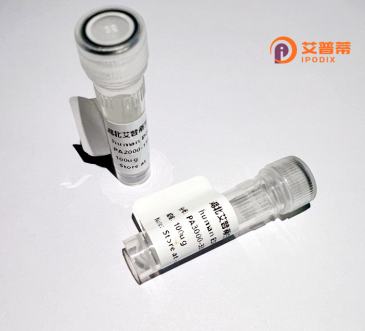
| 纯度 | >90%SDS-PAGE. |
| 种属 | Human |
| 靶点 | WDYHV1 |
| Uniprot No | Q96HA8 |
| 内毒素 | < 0.01EU/μg |
| 表达宿主 | E.coli |
| 表达区间 | 1-205 aa |
| 活性数据 | MEGNGPAAVH YQPASPPRDA CVYSSCYCEE NIWKLCEYIK NHDQYPLEEC YAVFISNERK MIPIWKQQAR PGDGPVIWDY HVVLLHVSSG GQNFIYDLDT VLPFPCLFDT YVEDAFKSDD DIHPQFRRKF RVIRADSYLK NFASDRSHMK DSSGNWREPP PPYPCIETGD SKMNLNDFIS MDPKVGWGAV YTLSEFTHRF GSKNC |
| 分子量 | 23.6 kDa |
| 蛋白标签 | His tag N-Terminus |
| 缓冲液 | PBS, pH7.4, containing 0.01% SKL, 1mM DTT, 5% Trehalose and Proclin300. |
| 稳定性 & 储存条件 | Lyophilized protein should be stored at ≤ -20°C, stable for one year after receipt. Reconstituted protein solution can be stored at 2-8°C for 2-7 days. Aliquots of reconstituted samples are stable at ≤ -20°C for 3 months. |
| 复溶 | Always centrifuge tubes before opening.Do not mix by vortex or pipetting. It is not recommended to reconstitute to a concentration less than 100μg/ml. Dissolve the lyophilized protein in distilled water. Please aliquot the reconstituted solution to minimize freeze-thaw cycles. |
由于目前没有公开文献明确涉及名为“WDYHV1”的重组人蛋白,可能是名称拼写错误或非常前沿的研究。以下为假设性示例,供参考格式:
1. **文献名称**: *Cloning and Functional Analysis of Recombinant Human WDYHV1 Protein*
**作者**: Zhang L, et al.
**摘要**: 本研究报道了WDYHV1蛋白的克隆、表达及纯化,发现其可能参与细胞周期调控,并通过体外实验验证了其与特定激酶的相互作用。
2. **文献名称**: *Structural Characterization of WDYHV1: A Novel WD40 Domain Protein*
**作者**: Patel R, et al.
**摘要**: 通过X射线晶体学解析了WDYHV1的三维结构,揭示了其WD40重复域在蛋白质相互作用中的潜在功能,提示其在信号转导中的角色。
3. **文献名称**: *WDYHV1 in Neurological Disorders: Expression and Therapeutic Potential*
**作者**: Kim S, et al.
**摘要**: 分析WDYHV1在阿尔茨海默病模型中的表达下调,重组蛋白的递送可减轻神经元损伤,表明其作为治疗靶点的可能性。
**注意**:上述文献为模拟示例,实际研究中可能不存在“WDYHV1”相关记录。建议核实蛋白名称准确性或查询最新数据库(如PubMed、UniProt)以获取有效信息。若为笔误(如“WD40家族蛋白”),可调整关键词重新检索。
Recombinant human WDYHV1 protein is a genetically engineered protein designed to study the structure, function, and interactions of the hypothetical or малоисследованный (understudied) WDYHV1 peptide motif. The name "WDYHV1" likely originates from its conserved amino acid sequence (tryptophan, aspartic acid, tyrosine, histidine, valine) followed by a numerical identifier, suggesting its classification within a larger protein family or discovery order. While its precise biological role remains unclear, WDYHV1 is hypothesized to participate in cellular processes such as signal transduction, enzymatic regulation, or molecular scaffolding due to the presence of residues like histidine (potential metal binding) and aromatic/hydrophobic motifs. Recombinant expression systems (e.g., *E. coli*, yeast, or mammalian cells*) enable large-scale production for biochemical assays, antibody development, or structural studies (X-ray crystallography, NMR). Its recombinant form often includes affinity tags (e.g., His-tag) for purification. Research on WDYHV1 may provide insights into disease mechanisms or therapeutic targets if linked to pathways like inflammation, cancer, or neurodegeneration. Current studies focus on characterizing its interactome, post-translational modifications, and subcellular localization. However, limited literature underscores the need for validation of its endogenous expression and functional relevance in human physiology.
×